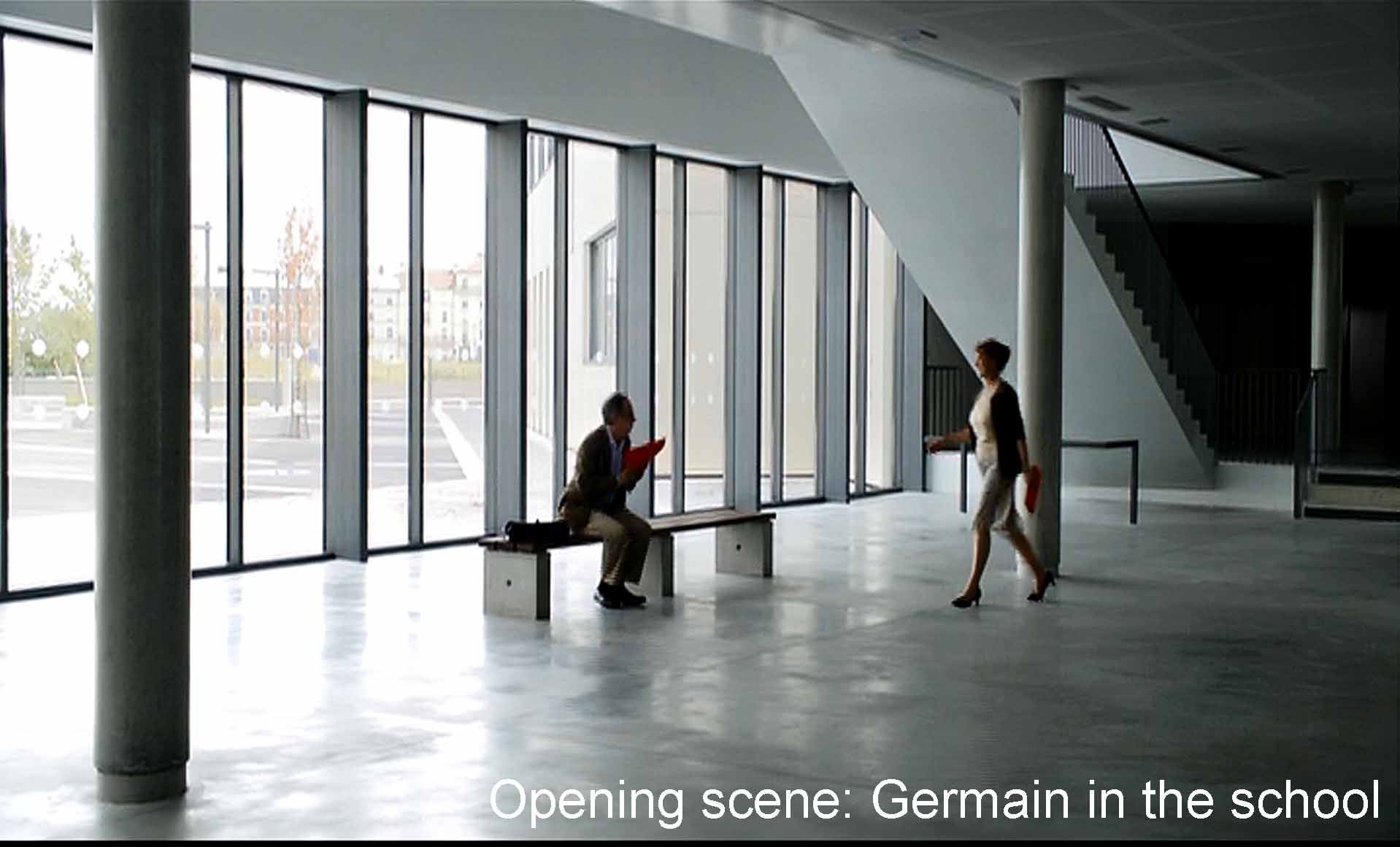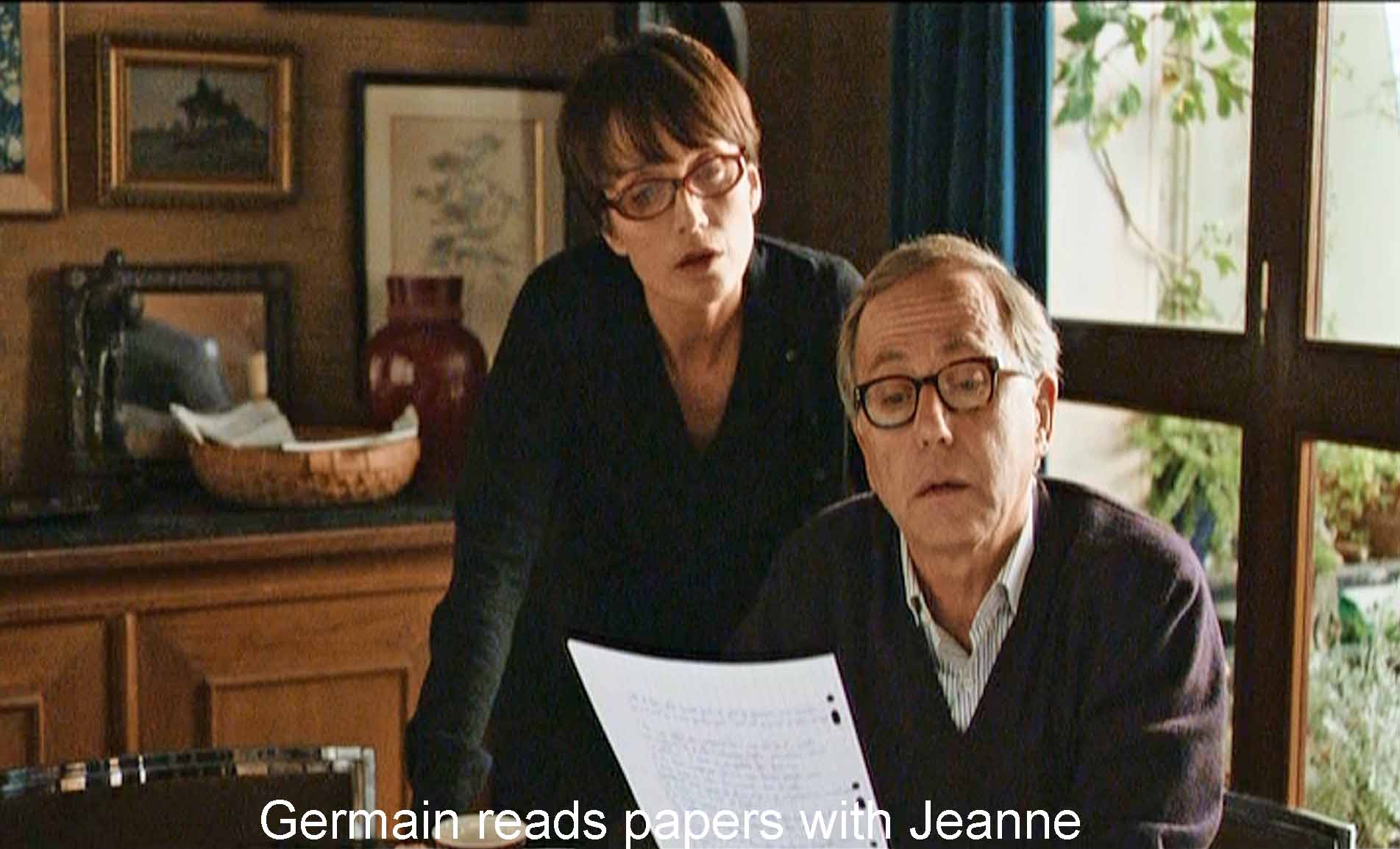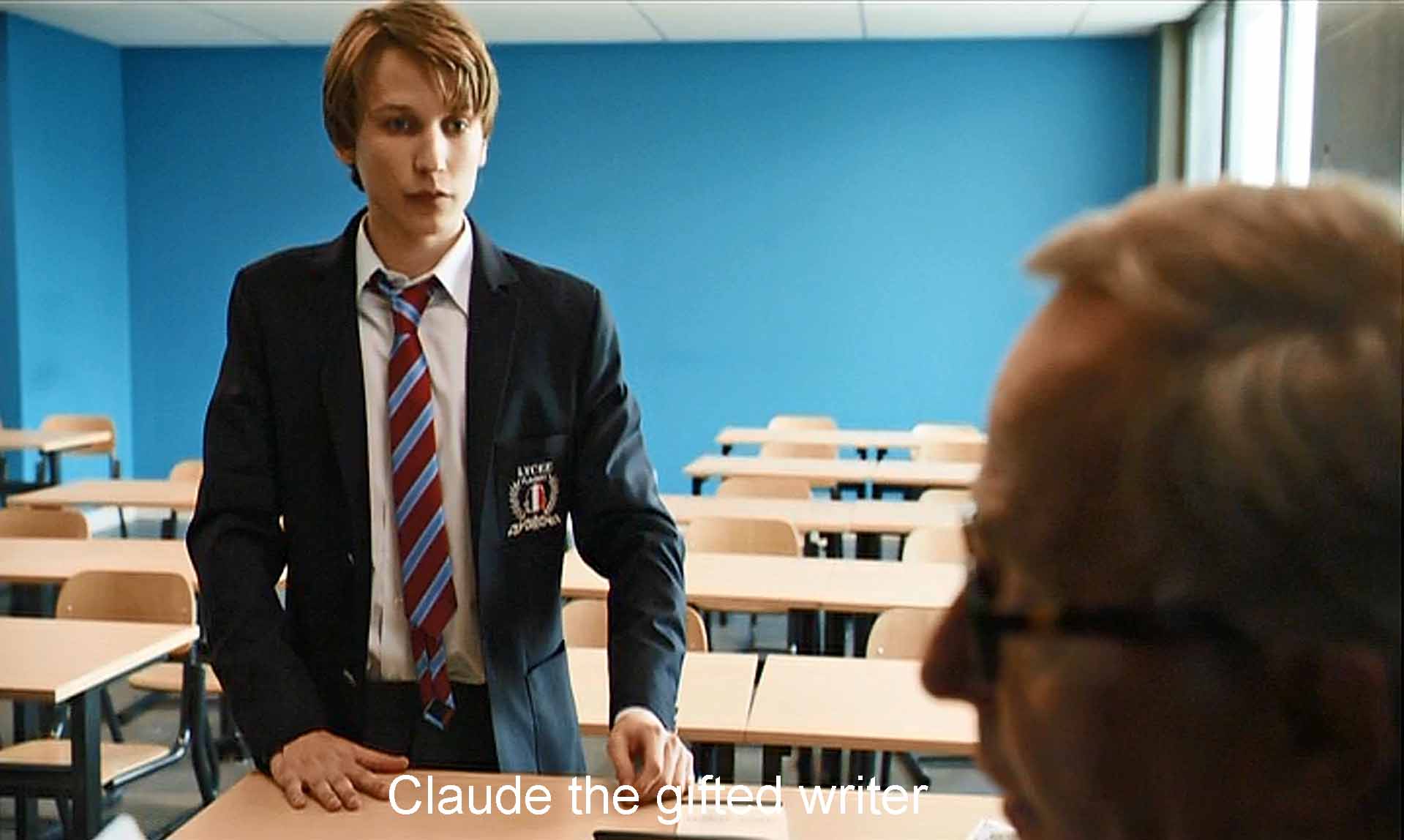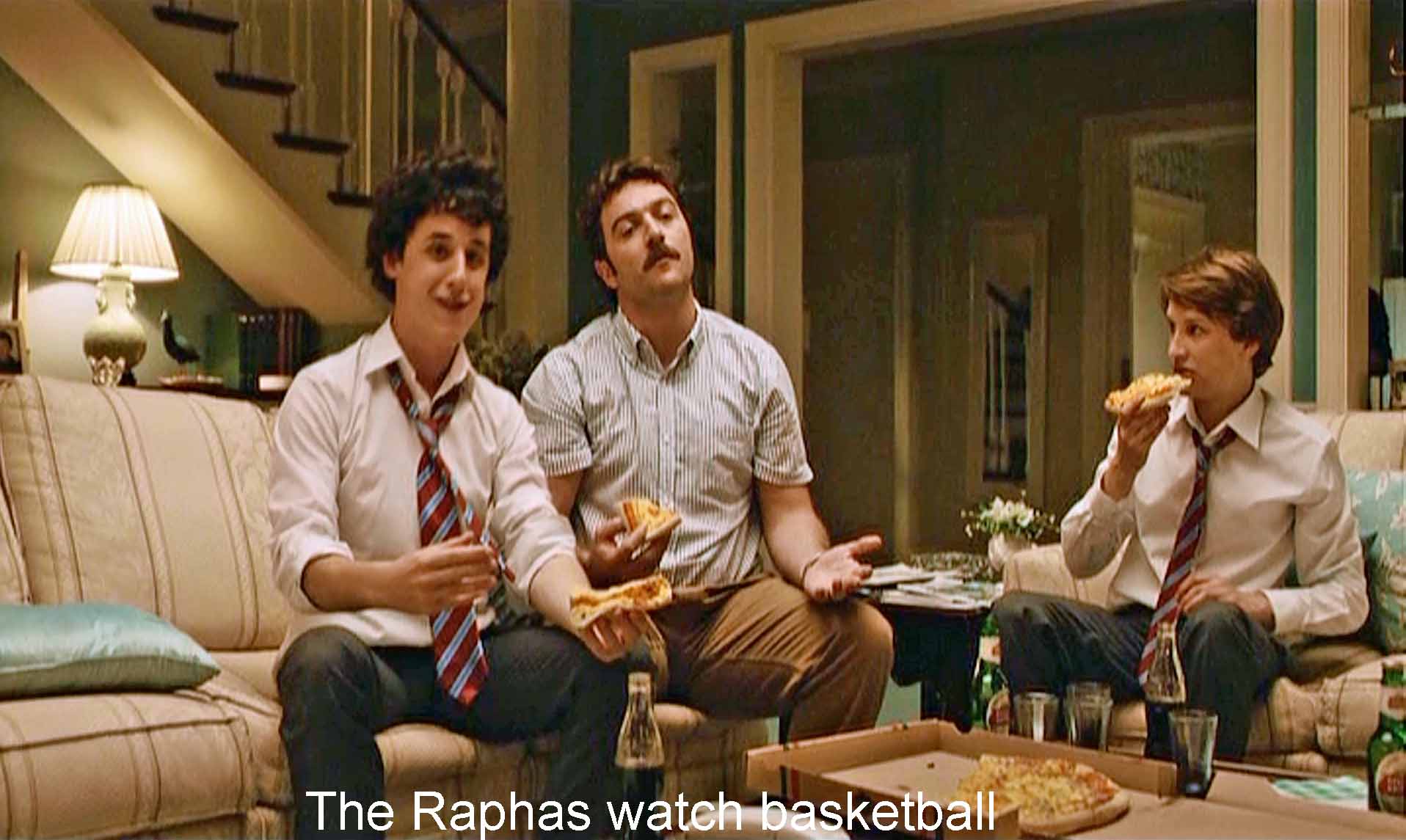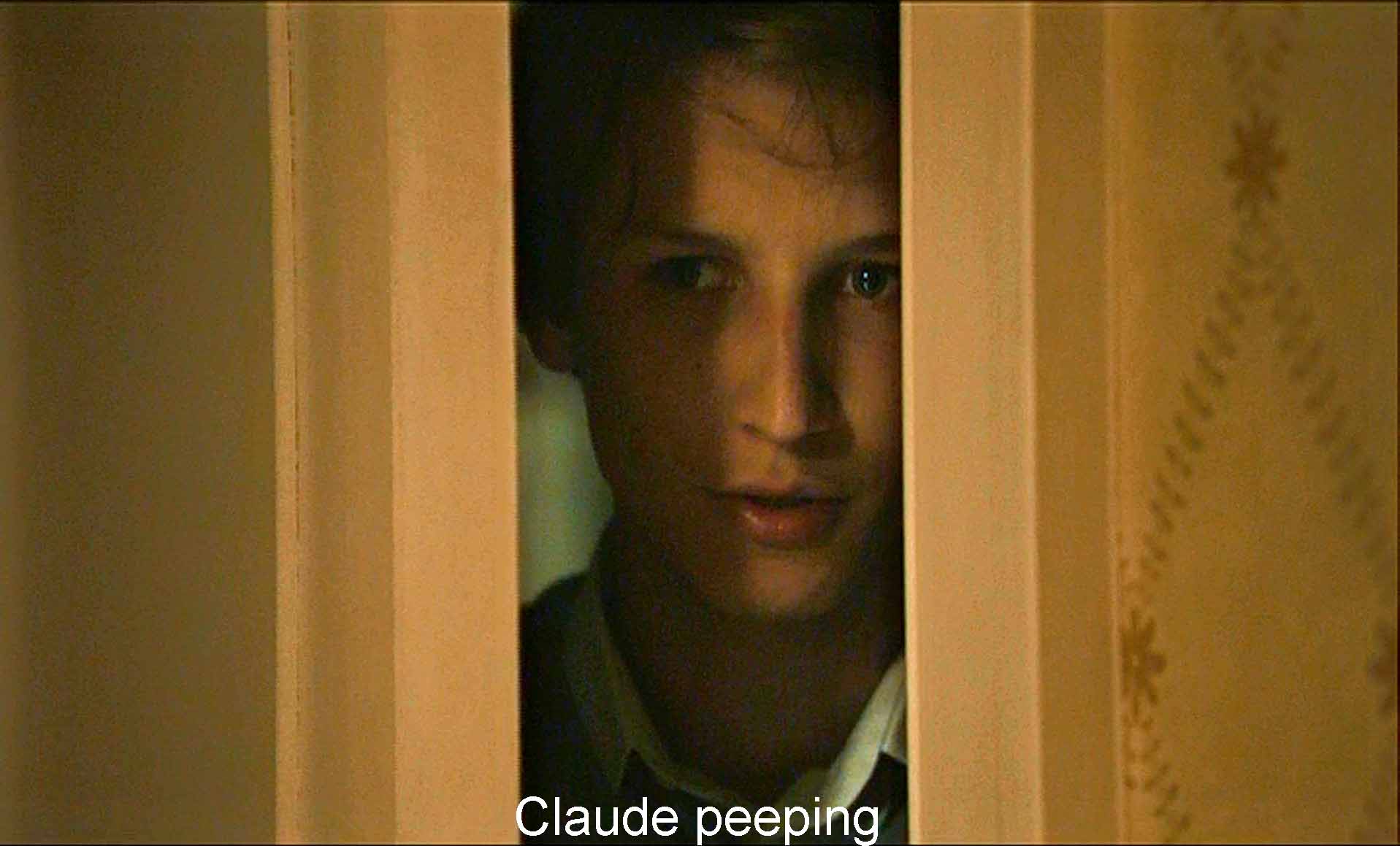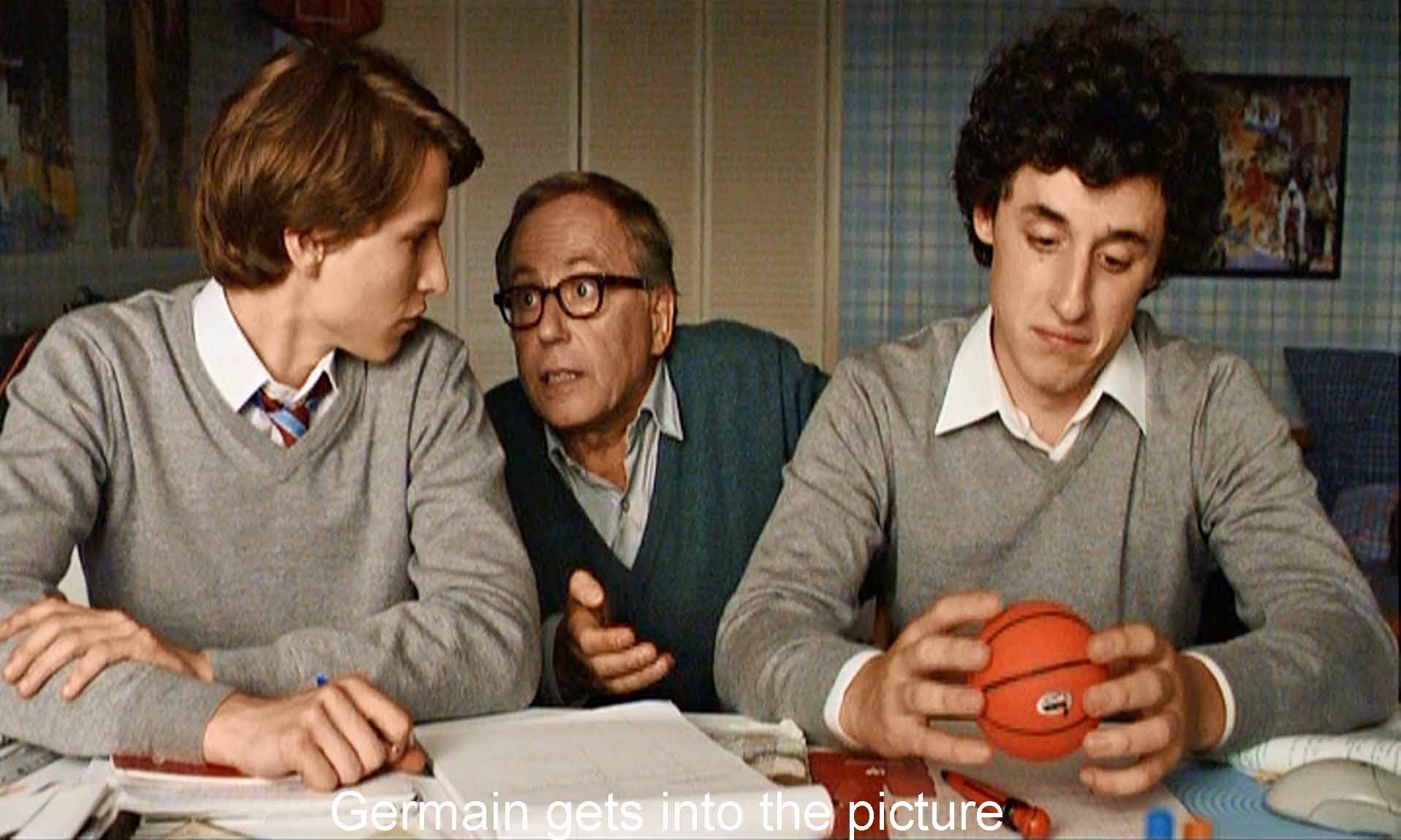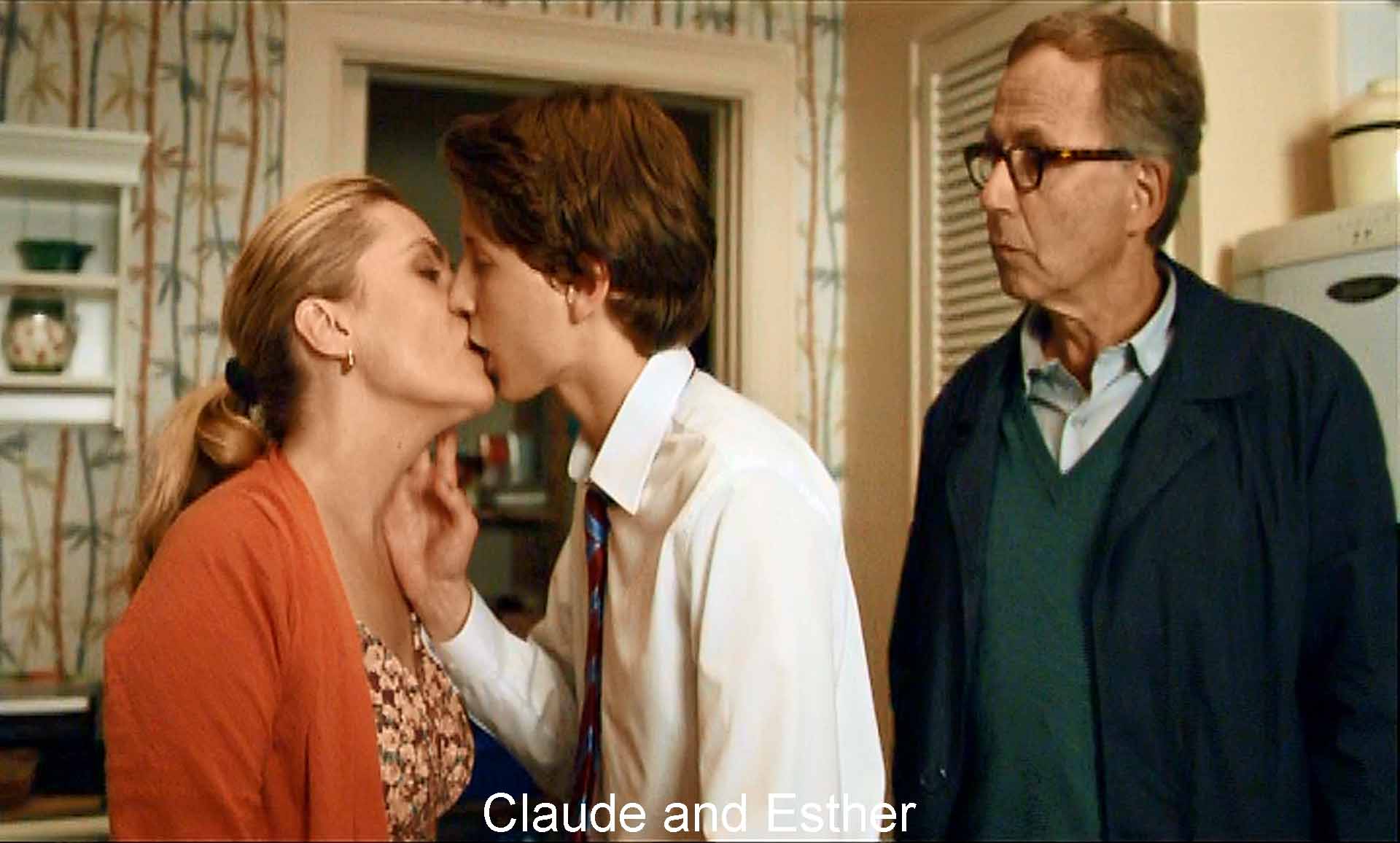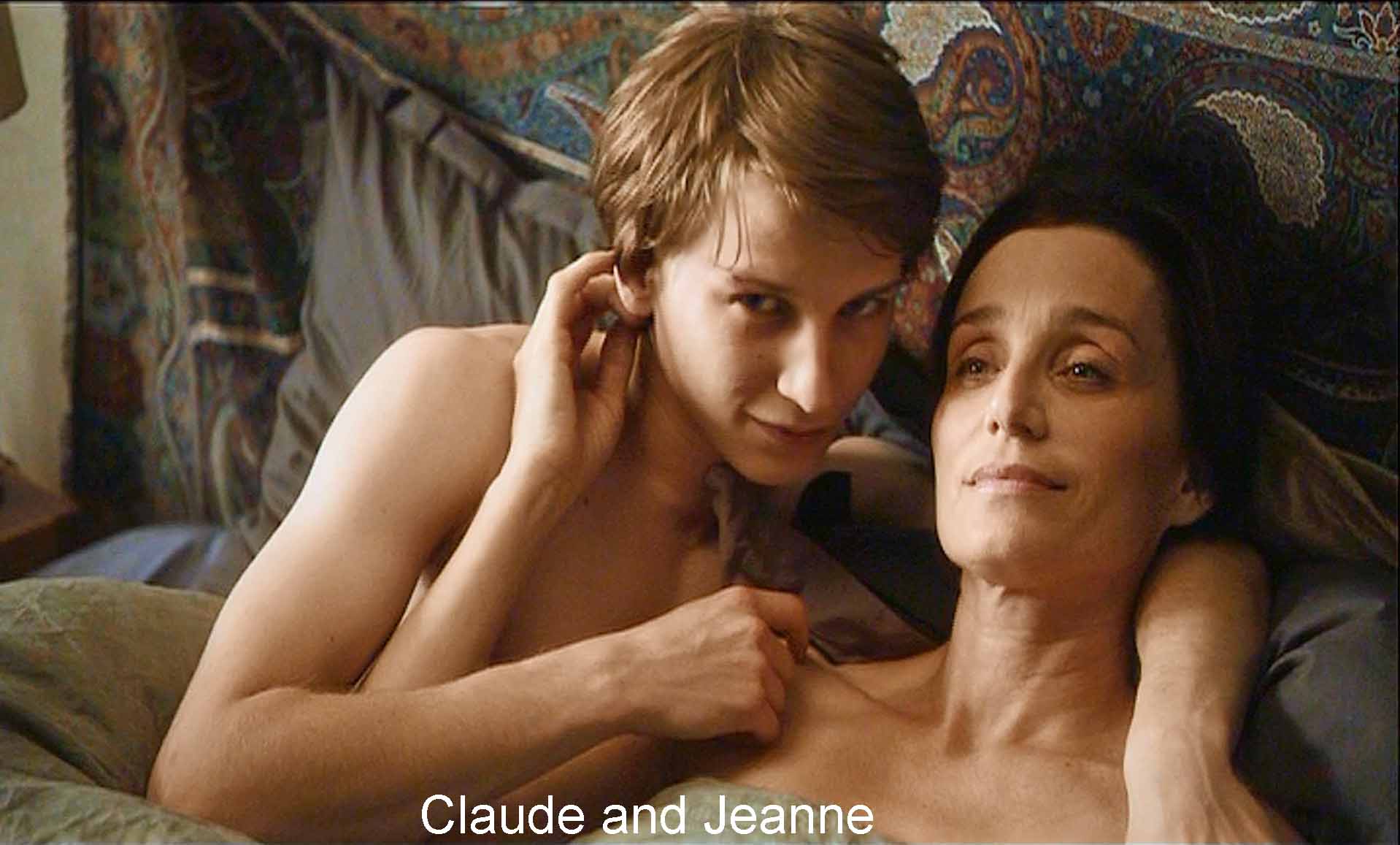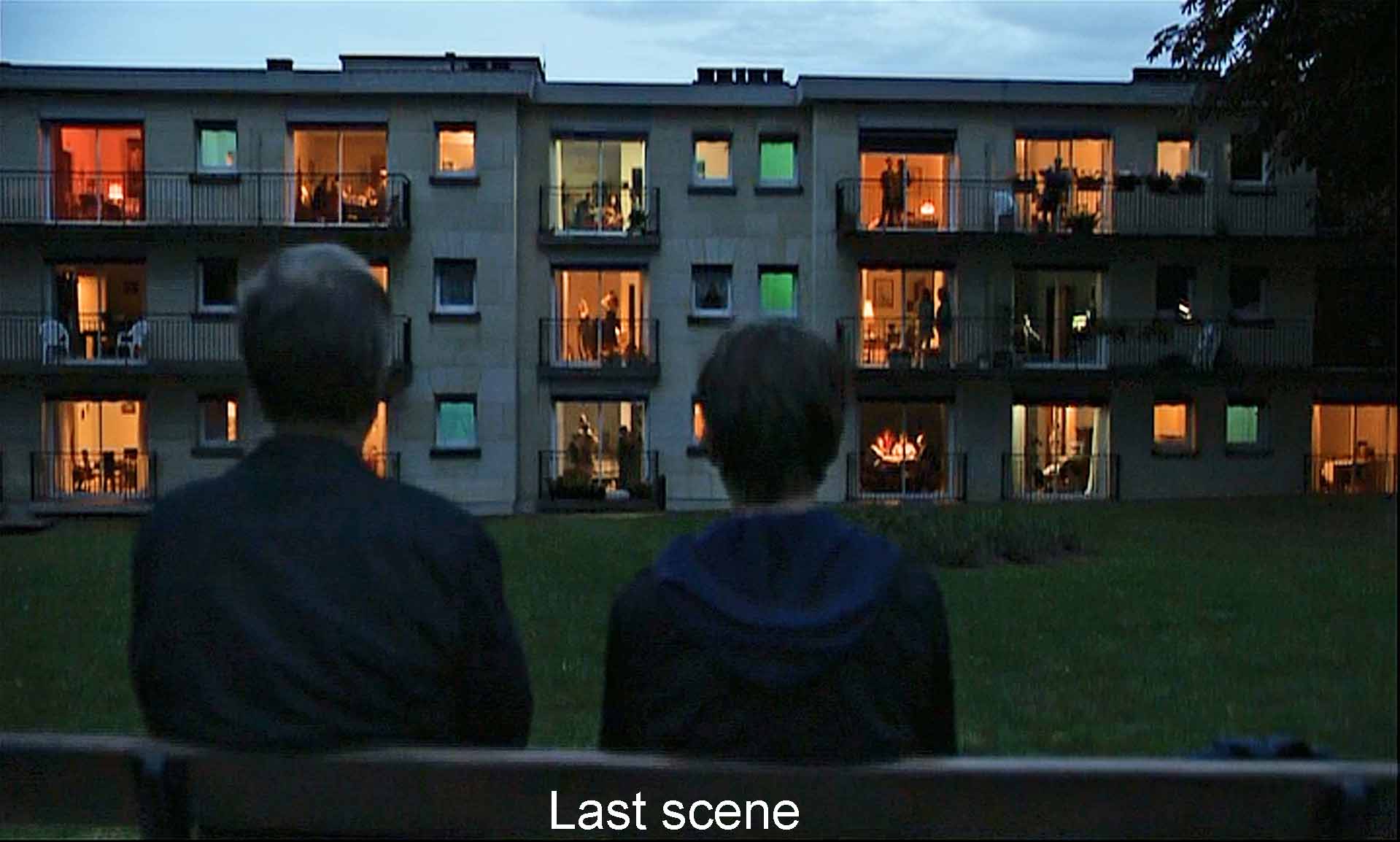Clearly, this film is about fiction and, in a larger sense, imagination or so it seems. Germain Germain (Fabrice Luchini) teaches literature and writing in a progressive school. His wife Jeanne (Kristin Scott Thomas) runs an avant-garde art gallery. Germain disgustedly reads to her the dumb two-sentence compositions that his new class has handed him when he comes upon one well-written two-page essay. It tells how its author, Claude Garcia (Ernst Umhauer), worked his way into the house of a classmate, Rapha (=Raphaël) Artole (Bastien Ughetto). All summer, Claude has been spying on the house and the father, Rapha Sr. (Denis Menochet), and the mother, Esther (Emmanuelle Seigner), with a mixture of envy and contempt. Contempt for their mindless middle-class pursuits. Envy because their house is four times bigger than his. Only late in the film do we get a glimpse of Claude’s threadbare situation. His mother has deserted the family leaving Claude to care for a wheelchair-bound father. No wonder he looks at the Raphas’ home with both desire and resentment.
This fiction-which-is-not-a-fiction blurs into the ”real” world it describes. Claude sneaks around the house at night peeping. He learns about the father’s job troubles and sees the parents sleeping and imagines their sex. Claude’s telling what he sees starts to become telling what he imagines or what he causes. Then Germain begins appearing in scenes in the Raphas’ house, and Claude persuades Germain to do things at school outside the story to keep the story going. Gradually, the action develops from peering and peeking to causing changes in the movie-reality. And we realize—or I realize—that I’m not just watching Claude create his fiction, I’m also watching Ozon create his. He draws me into his film just as Claude draws his teacher into his story.
This seems a movie about fiction and writing fiction and its relation to reality and a reader’s getting involved in fiction, and it is surely all those things. But, as I’ve often written on this web page, we need to look at the opening and closing shots. Ozon gives us an elaborate opening over the credits (on school paper), and it is not about fiction or imagination at all. Here are the scenes:
- in the empty, sterile hall of the super-modern Lycée Gustave Flaubert, Germain waits for a fellow-teacher. Together they go to a faculty meeting.
- There the principal explains that they are a pilot school, where reforms will be tried out. In a symbole audacieux, given the very diverse population of the school, the students will have to wear the traditional school uniform so as to make them all “equal.”
- We see (from the neck down) a student dressing: socks, white shirt, gray trousers, black shoes, necktie with the school colors, blue blazer.
- Shift to fast motion: First one student, then a crowd of them, all dressed uniformly, assemble in the school courtyard, then pile into the sterile hall.
- More fast motion as the screen fills with 200 identification pictures of students 10 rows of 20, then jumps to 8 rows of 16, 5 x 10, 4 x 8, 3 x 6, 2 x 4, and finally 1 x 2. These last two are the two students central to the film, although we do not know that yet.
- Cut to the title screen and the beginning of the film proper. Jeanne returns from the funeral of the owner of her gallery worried about her future. Germain reads student papers to her, coming on the unique paper by Claude Garcia.
In the opening, then, Ozon has introduced quite another theme besides fiction: the contrast between the uniformed students and the teachers in their highly individual corduroys, between the students compressed into uniformity by the school and the highly individual Jeanne and Germain.
In the closing scene, Germain the teacher, who by the end has lost job and wife because of his love for Claude’s fiction, has fetched up in the Institut LaVerrière, a rest home for burned-out, depressed teachers. Claude visits him and together they stare at the apartment windows across the street (in an obvious echo of Hitchcock’s Rear Window). Seeing two women quarrelling, Germain the bourgeois says they are two sisters arguing over inherited property; Claude sees two lesbians breaking up.
We end as we began with the tension between the uniform (the apartment windows) and the unique (the two stories). All the complex ideas about fiction that make up most of the movie need to be set in the context of this school, trying to make its “learners” equal. In the Lycée Gustave Flaubert, the Flaubert signals the theme of fiction but the Lycée frames the tale as a whole.
Ozon develops this idea of uniformity by doubling and twinning things, most obviously in the names: Germain Germain and the two Raphas. Then two twins have inherited Jeanne’s gallery, twins that look different despite being played by the same actress (Yolande Moreau). Jeanne’s artworks also play with this idea of uniqueness and uniformity. She shows naked dictators (Stalin, Hitler) with breasts and vaginas, unique to the point of being impossible. (Rapha Jr. calls this porn.) Jeanne shows pictures of the sky by a Chinese artist that seem almost identical, although the twins comment on differences.
China is a theme all through the film, Jeanne’s artist and Rapha Sr.’s job involving Chinese manufacturers of identical objects. China: a billion people all different but all the same in being “Chinese.” And of course Germain was looking for variety in his student papers but got uniformity, except for Claude’s.
Most importantly, “in the house” Claude learns to see the Artole family as individuals, not just instances of the middle class as he had seen them at first. In a famous line from this film, Claude says he smelled “the distinctive scent of a middle-class woman.”
At the end, both Germain and Claude choose this peculiar kind of reality-fiction as they plan more stories when Claude works his way into the apartments across the street. They have chosen the infinite variety of fiction over the pressure toward uniformity at the school. As Ozon has said, “They chose fiction over reality. That is where they feel alive.” Certainly not in the school; these two are escaping the frame.
So is Ozon. Ordinarily he likes to skewer the middle-class, bourgeois family. Here he does, somewhat, but he ends by doing the opposite. When Claude comes on to the wife in the Rapha household, she fends him off. The family stays together and heads off to China. But when Claude comes on to his mentor’s wife—he tells her a lie about Germain to get her angry at him—she takes a wife’s revenge on her husband. She has lost her gallery, he has lost his job, each has lost the other, and the family falls apart.
Uniformity and difference, fiction and the way we get involved in it, class conflict, and there are still other things we could talk about prompted by this delightfully complex film: what is art, a question surely posed in Jeanne’s hypermodern gallery; Germain’s pedagogical style; father-son bonding as opposed to no children at all, and more. Perhaps the most important thing I haven’t mentioned is the body. Critics link Ozon to the cinéma du corps or the “New French Extremity.” These are films that do extreme things to bodies by way of sex or horror. This film doesn’t go to extremes, but it does suggest that, for all the supposed power of fiction, it is finally physical presence and bodies and sex that matter. François Ozon has created a rich film that we movie lovers will be watching and thinking about for a long time.
